The 2020 Election brought unrivaled spending with Democrats consistently outspending Republicans, in some cases spending four times the amount of money on candidates. As discussed in previous columns, there was also unmatched private spending on election administration, as seen with the Chan-Zukerberg grants for local elections.
Political campaigns and committees in the 2020 General Election received unprecedented funds, crushing the spending in other election cycles, according to data collected by OpenSecrets.org. The 2020 election was also double the cost of the 2016 election, totaling nearly $14 billion compared to an average of $7 billion in previous general elections.
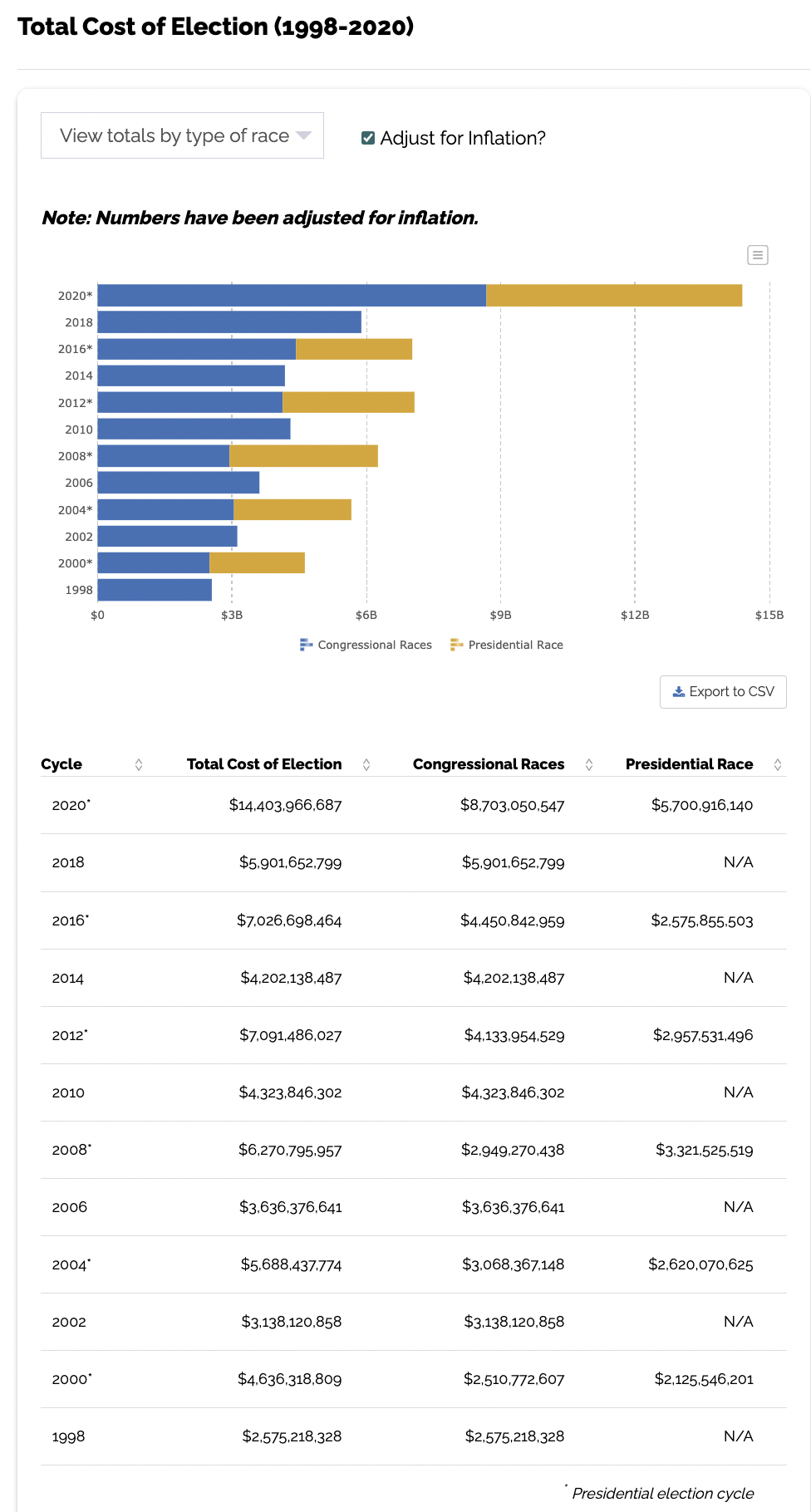 Cost of Elections/OpenSecrets.org
Cost of Elections/OpenSecrets.org
In the 2020 presidential race, Democrats outraised and outspent Republicans, donating four times the amount of money to an initial field of 28 candidates, as shown in screencap 1. When filtered for the final general election slate of candidates, Democrats still spent more money on the presidential race but had four candidates sharing the spoils, as seen in screencap 2 below. Individual donations for Democrats also exceeded those for Republicans.
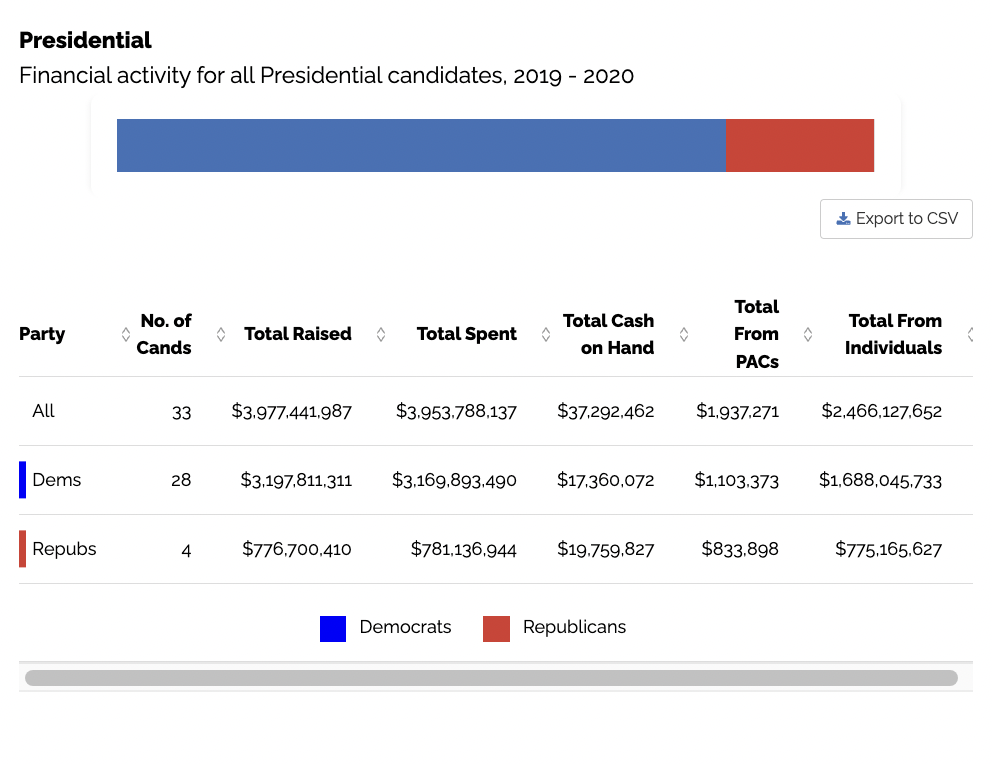 Presidential Candidates/Open Secrets/Screencap 1
Presidential Candidates/Open Secrets/Screencap 1
 Final slate/OpenSecrets.org/Screencap 2
Final slate/OpenSecrets.org/Screencap 2
2020 spending was high in congressional races, but the differences between fundraising and spending in 2020 and those in 2016 were not quite as stark as for the presidential race. Democrats, in 2020, spent more on congressional candidates in general, although Republican PACs invested more in Senatorial races both before and during the General Election seasons. Individuals again donated more to Democrat races than they did to Republican races. Screencap 3 below shows fundraising and spending for all congressional races. Screencap 4 shows general election congressional race fundraising and spending.
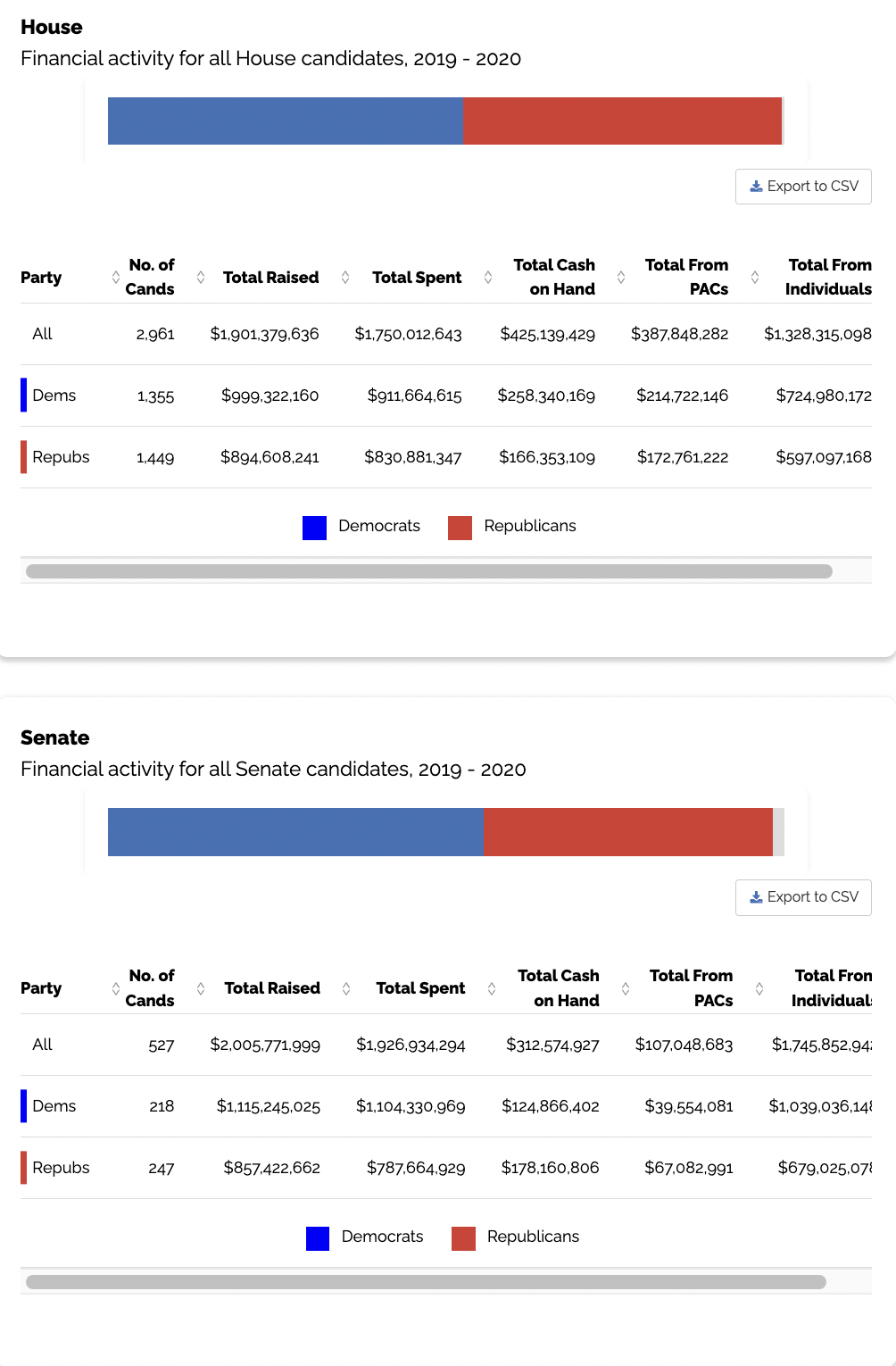 Congressional races/OpenSecrets.org/screencaps 3
Congressional races/OpenSecrets.org/screencaps 3
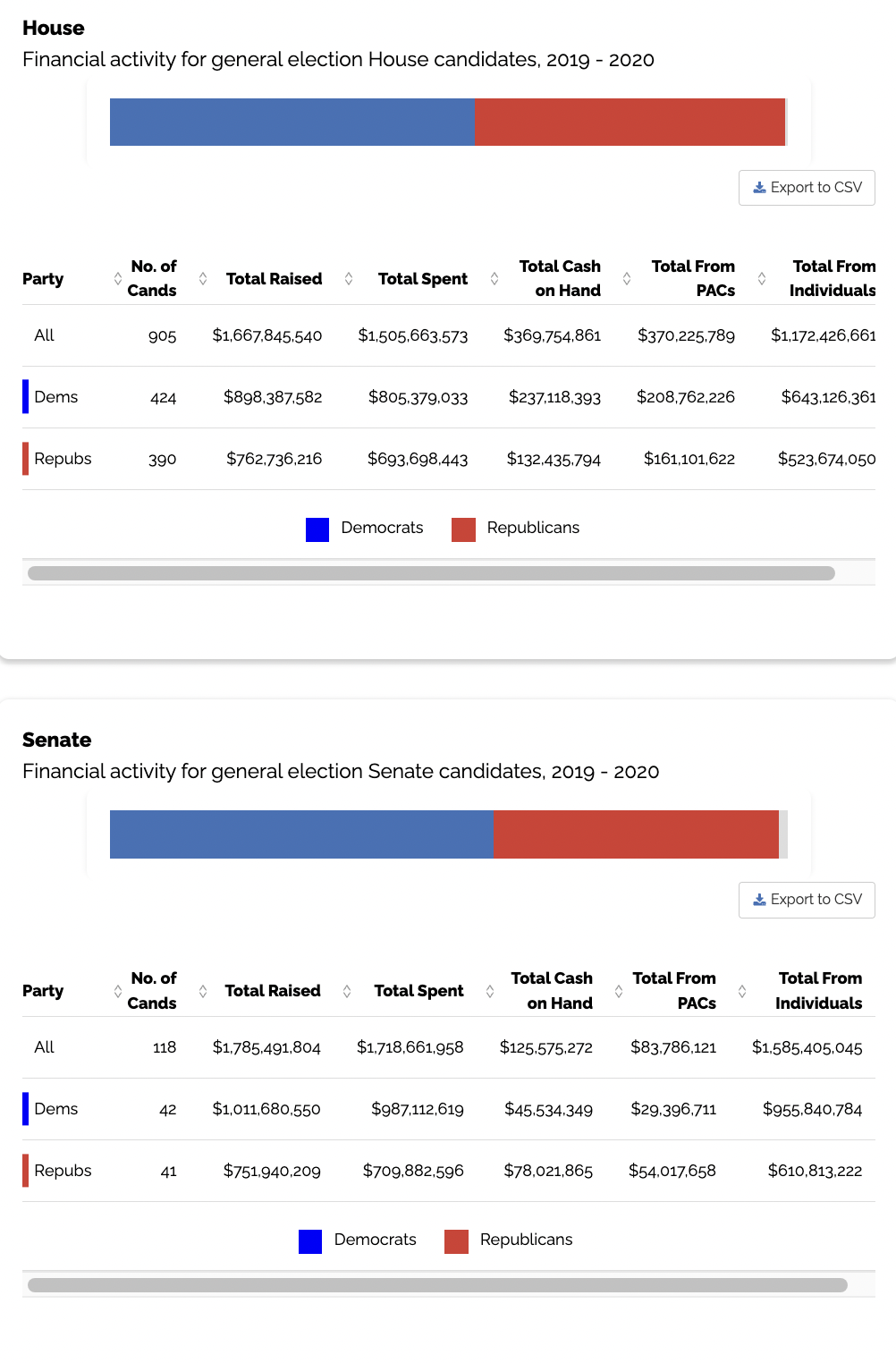 Congressional fundraising and spending/General Election and spending/OpenSecrets.org/Screencap 4
Congressional fundraising and spending/General Election and spending/OpenSecrets.org/Screencap 4
Small Donors Played a Huge Role in 2020 Fundraising Efforts
The rabbit hole is deep, and there are several ways to parse the data. However, a look at candidates and donor behavior yields some interesting results. For the 2020 congressional seats in the category of large versus small individual donations, Democrats occupy 14 of the top 25 slots when looking at the totals raised. Three Democrats are in the top three slots; Liberals Jon Ossoff, Raphael Warnock, and DNC Chair Jaime Harrison. Two Republicans occupy slots four and five; RINO Lindsey Graham and another RINO, Georgia runoff candidate David Perdue. Ossoff raised approximately $154 million, and Perdue raised about $102 million.
However, it is the small donor data that really stands out. Democrat Candidates who raised money through small donors killed it in 2020. Warnock raised almost $146 million, but he wins the title for bringing in the highest dollar amount from small donors, almost $72 million. Harrison and Ossoff are right behind him with small-donor donations at almost $71 million and $70 million. Lindsey Graham was the only Republican in the top five of small donor donations, occupying the fifth slot with about $51 million in donations. Amy McGrath raised a lot of money from small donations, but she was beaten by the fossil incumbent, Mitch McConnell in Kentucky. Kentuckians poured money into her race and ended up betting on the wrong horse.
The first table shows the top five for total raised. And the second table filters for percent from small donors. In 2020, Democrats occupied 16 out of the top 25 small-donor slots.
:
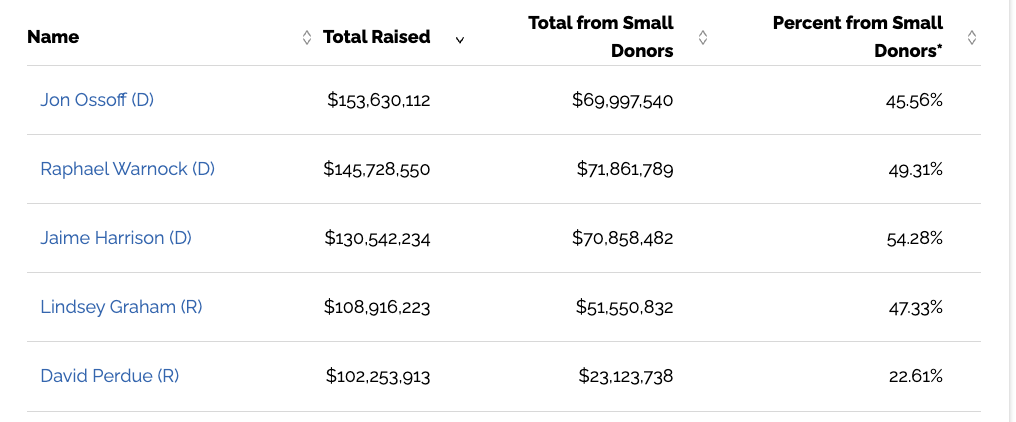
 congressional top 5/Opensecrets.org
congressional top 5/Opensecrets.org
Now let's look at the 2016 race. Elizabeth Warren was in the top spot for fundraising. She raised a total of $51,431,099. That is a fraction of what Ossoff raised in 2020. She brought in around $25 million from small donors, again a fraction of Warnock's spoils. The top five still had three Democrats and two Republicans, but 2020 candidates dwarfed their fundraising totals and small donor donations. In 2016, 19 out of the top 25 slots for small-donor donations were occupied by Democrats, and all of the top 5 slots for small donors were Democrats in 2016.
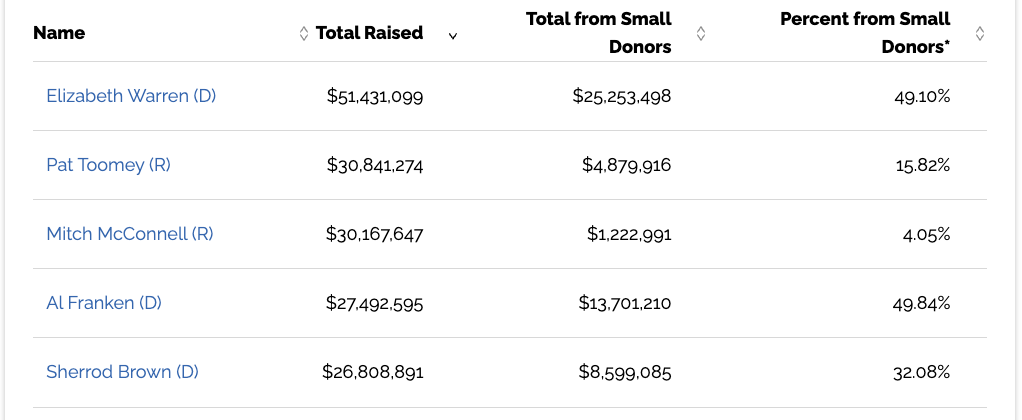
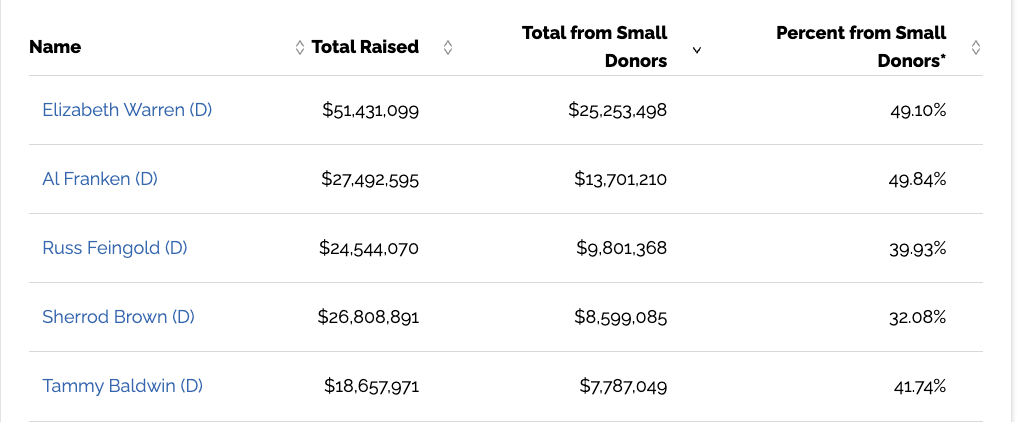 fundraising/opensecrets.org
fundraising/opensecrets.org
Top 20 PAC: Total Raised in 2020 and 2016
The left-leaning Political Action Committee (PAC), ActBlue, absolutely hammered it in 2020, smashing their 2016 fundraising numbers. ActBlue raised $4,318,377,981 in 2020 and, in 2016, they raised $653,653,733. It wasn't even close. Conservatives amped up their game with WinRed, founded in 2019 to combat Democrat fundraising. WinRed came in second but still significantly behind at $2,240,123,104.
The Left-leaning Priorities USA Action was in second place in 2016. Soros Fund Management heavily supports them. Right to Rise, a conservative super PAC that supported Jeb Bush, was in distant third place in 2016, raising only $121,695,224. The conservative Senate Leadership Fund was in fourth place, and the Liberal NextGen Climate Action occupied the 5th slot. The 2016 top five PAC fundraisers and the 2020 top five are captured below:
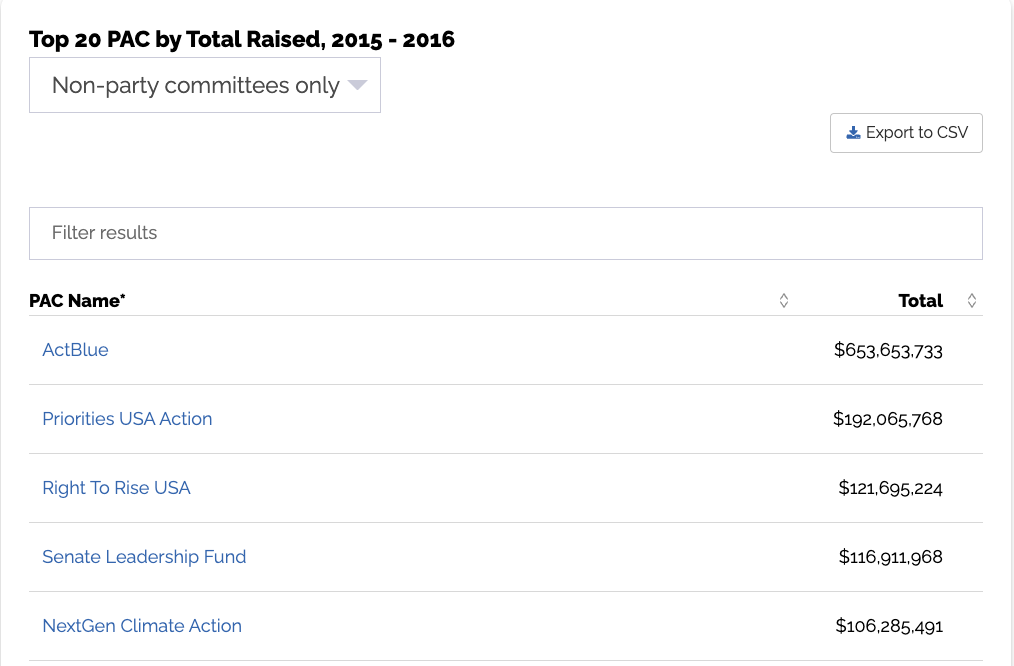
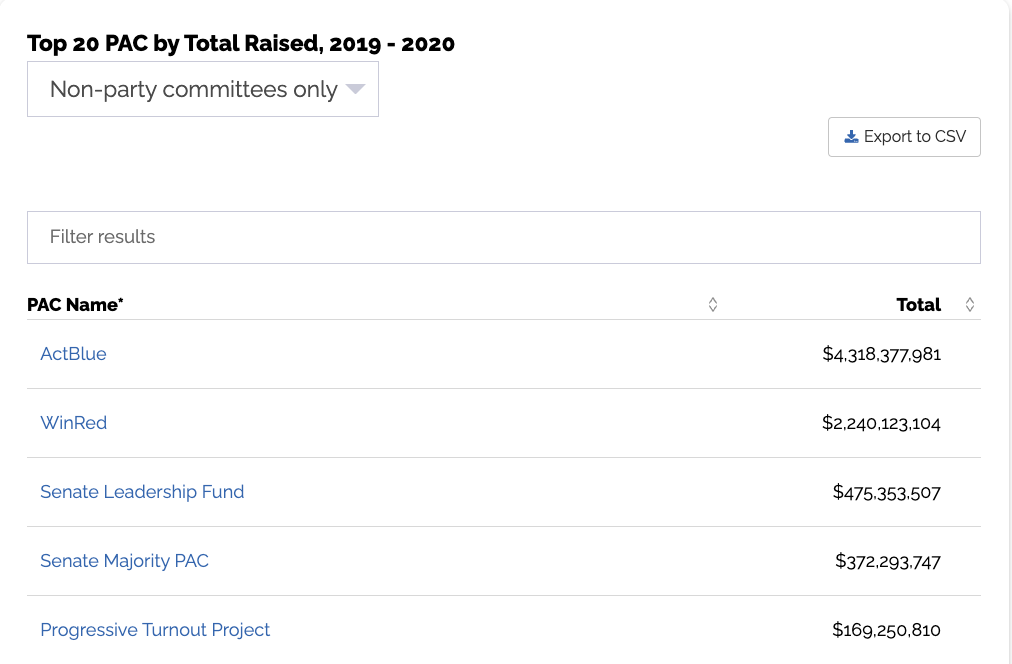 Top 5 PACs/OpenSecrets.org
Top 5 PACs/OpenSecrets.org
The Biggest Individual Donors
In 2016, environmentalist Tom Steyer and his activist wife Kathryn Ann Steyer were in the top spot with about $91 million. The conservative-leaning Las Vegas Sands/Adelson Drug Clinic was second with about $83 million. Six of the top ten individual donor slots were occupied by Democrats in 2016.
In 2020, six of the top ten biggest individual donors spots flipped to Republicans, according to OpenSecrets. The Las Vegas Sands/Adelson Drug Clinic was the top donor with about $218 million in total contributions. Democrats Michael Bloomberg and Thomas and Taylor Steyer occupy slots two and three. Two Republicans occupy spots four and five. Fundraising by top individual big donors in 2020 more than doubled compared to 2016.
Top Organizations That Donated
In 2016, Tom Steyer's climate change outfit, Fahr, LLC, was in the top spot, with donations to Democrats of almost $91 million. "Fence sitter" or allegedly "politically neutral" Renaissance Technologies was in second place, with $59,757,578. However, a deeper look indicates they lean left because most of their donations went to Democrats in 2016. Las Vegas Sands was in the third spot, showing about $44 million in donations to Republicans. Seven of the top ten organizations were Democrat donors in 2016. Soros Fund Management was in slot nine with about $29 million in donations.
Bloomberg, who arguably hated Trump, came out swinging in 2020. He was in the top spot and donated $171,768,387, almost double Steyer's donations in 2016. Bloomberg and his affiliates donated mostly to ultra-liberal PACs. On the other hand, Fahr, LLC was in sixth place in 2020, with around $71 million in contributions. Renaissance dropped to the 27th spot. The top ten contributions were split 50-50 between Republicans to Democrats in 2020. 31 out of the 51 top donations from organizations were Democrat-leaning. There were 28 Democrat-leaning organizations in the top 51 in 2016.
Election Trends
It is undeniable that the cost of elections is on the rise if OpenSecrets has done its homework correctly. Beginning in 1990, the first data shown as collected on the site, the average House winner spent around $407k to run a race. In 2020, it grew to $2.35 million. In the Senate, a winning seat cost $3.87 million, but in 2020, it jumped to $27.16 million.
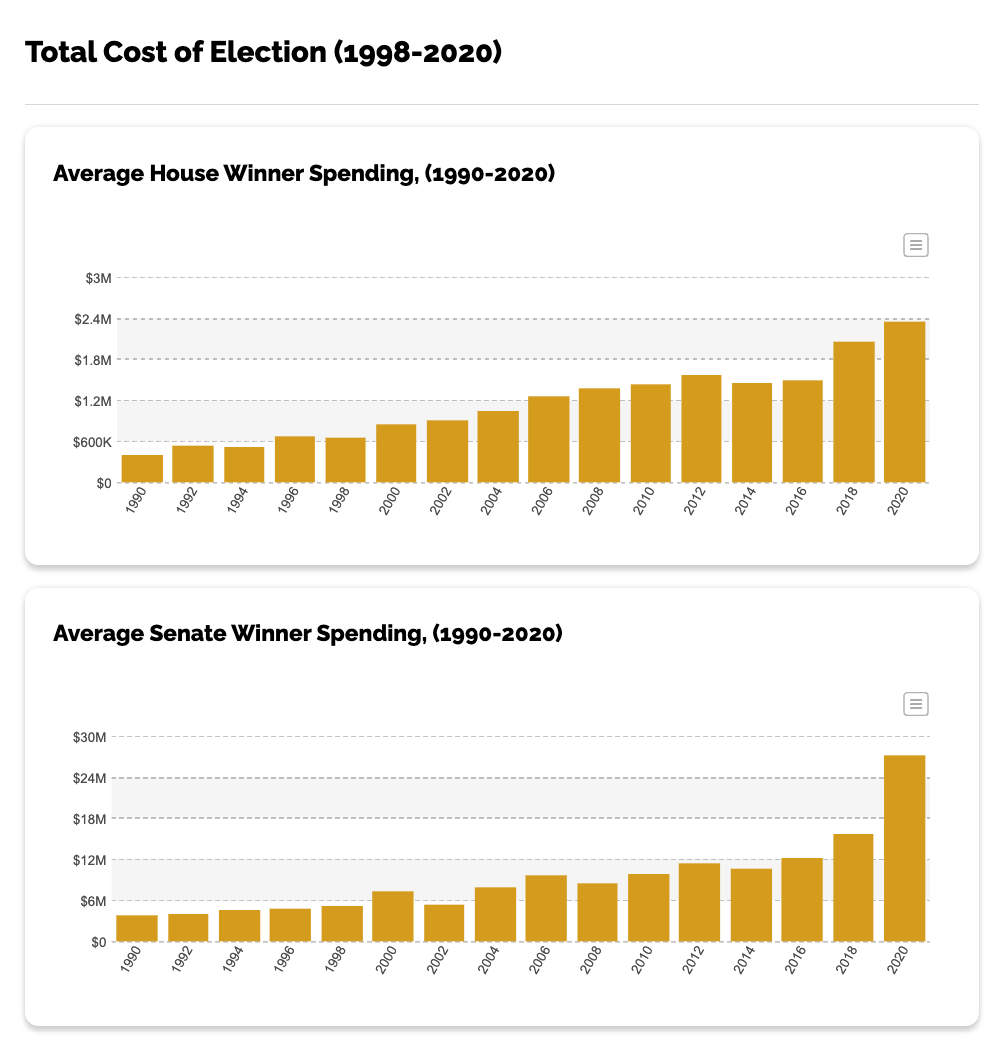 Election Costs are Rising/OpenSecrets.org
Election Costs are Rising/OpenSecrets.org
In the 2016 General Election cycle, an average winner spent $1,495,633 in the House, and in the Senate, the average winner spent $12,159,217. PAC receipts for the average House winner in 2016 were about $738k, and for an average Senate winner, PAC money averaged about $2.9 million. Republican Paul Ryan (R-Wis) ran up the biggest bills for his campaign on the House side. In the Senate, it was Pat Toomey (R-Pa.). Kevin McCarthy (R-CA) had the most PAC receipts in the House, and Toomey had the most on the Senate side.
 Average Spending/OpenSecrets.org
Average Spending/OpenSecrets.org
In 2020, again, the numbers were much higher in all areas studied. An average House winner spent $2,354,60. An average Senate winner spent $27,157,566. The most expensive campaigners were Steve Scalise (R-La) in the House and Jon Ossoff (D-Ga.) in the Senate. Notably, two Democrats ended the year with the largest campaign balances, Adam Schiff of California and Georgia's Raphael Warnock.
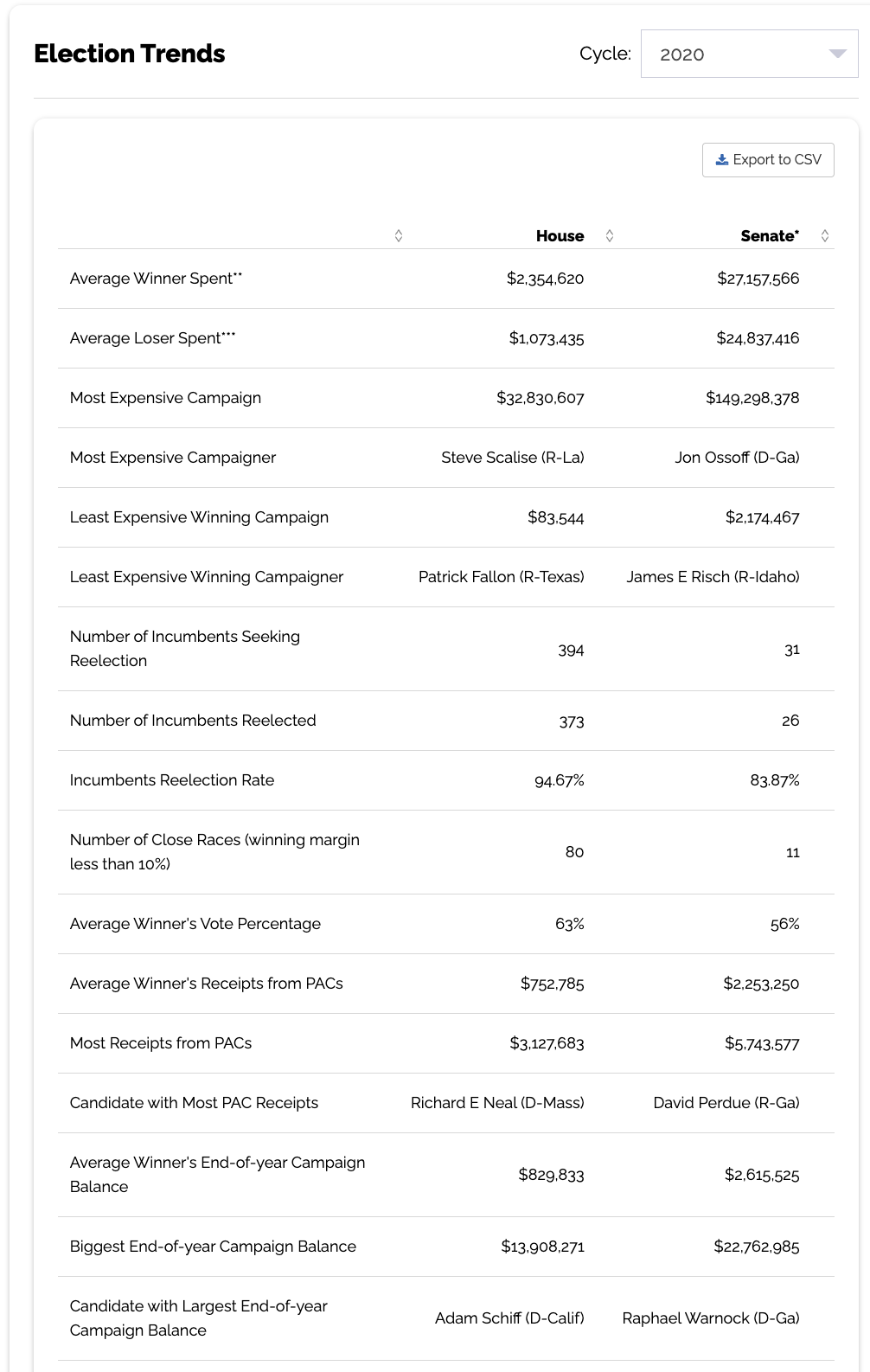 Election Trends 2020/Big Spenders
Election Trends 2020/Big Spenders
According to OpenSecrets.org, PACs overwhelmingly give to incumbents.
"Political action committees (PACs) have one overriding mandate: get the most bang for the buck. To maximize their dollars, nearly all PACs—particularly those of business groups—give the overwhelming proportion of their campaign dollars to incumbents. With congressional re-election rates typically in the 90 percent range, from their point of view, that's a sound investment. Labor groups also give heavily to incumbents. Ideological groups, on the other hand, are much more likely to take a chance on political newcomers."
Most Expensive Congressional Races in 2020
The Georgia Senate race occupied the top two spots in 2020 for the most raised, followed closely by the South Carolina Senate race. Arizona and Kentucky were in the fourth and fifth spots.
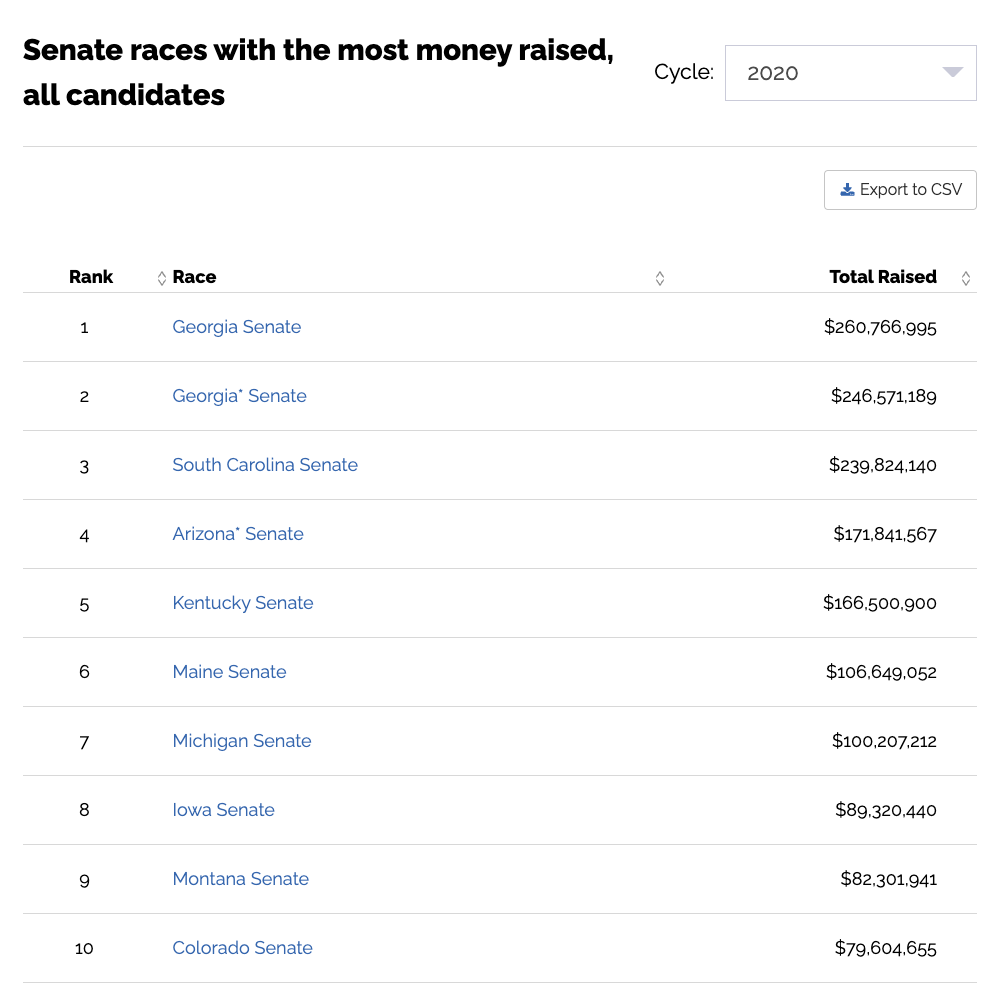 2020 Congressional Races
2020 Congressional Races
In 2016, Senate races in Florida, Pennsylvania, Wisconsin, Ohio, and New Hampshire took the top five spots. But the funds raised were small compared to those raised in 2020.
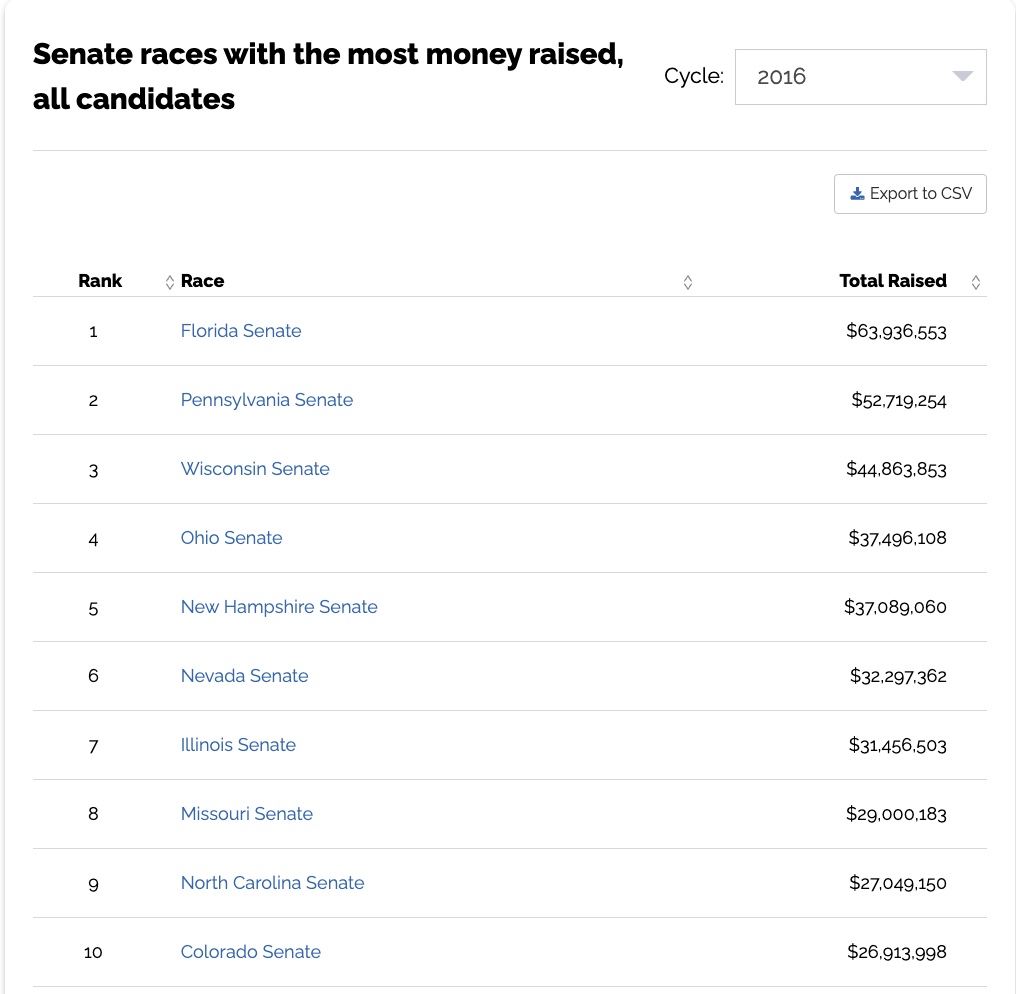 Senate Races/2016
Senate Races/2016
Outside groups spent a lot more in 2020 than they did in 2016 on Senatorial races, spending orders of magnitude more in many cases.
What Could This Mean for 2022 and 2024?
If trends are good indicators of future fundraising and campaign costs, then both 2022 and 2024 could be two of the most competitive in history. Trump's competitors have a tough act to follow in the presidential race. He "remains the most prolific fundraiser in the Republican Party. His Save America political action committee has brought in over $125 million since its launch soon after the 2020 election and had over $110 million in its coffers as of the end of February." DeSantis is right up there with Trump. He has reportedly raised about $110 million for his gubernatorial run in 2022, "according to figures filed with the Florida Secretary of State." Lawmakers are also raising record-breaking numbers for the 2022 Congressional races.
The Democratic National Committee (DNC) and the Republican National Committee (RNC) have also reported having raised record amounts of money in 2021 in preparation for the 2022 election. "The DNC raised $63.7 million through the first four months of 2021, more than twice as much as it raised over the same period after the 2016 election. The DNC had $56.3 million in the bank through April, six times its 2017 total."
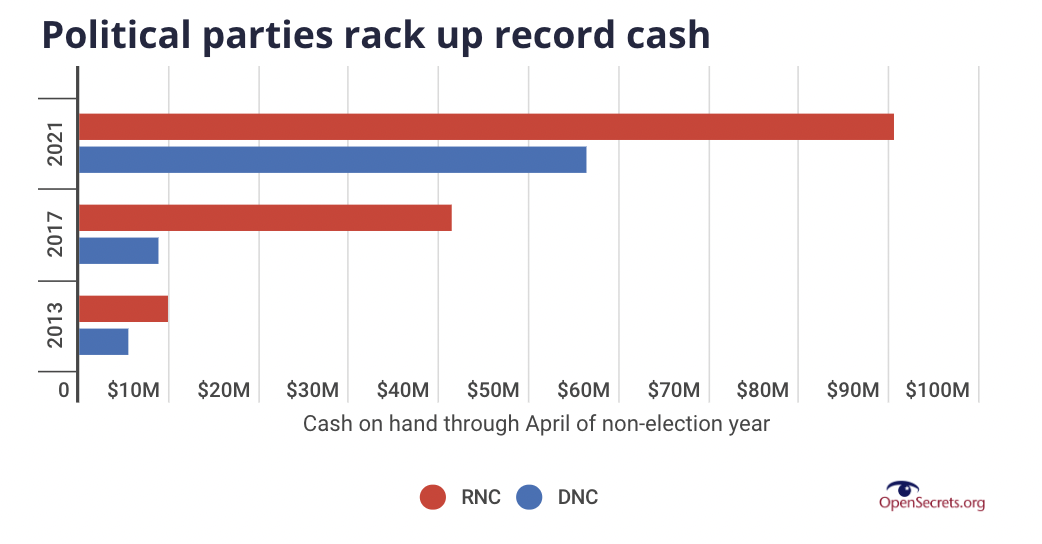
Fundraising
The DNC reportedly hauled in $14 million in February of 2022 alone. However, Republicans are reportedly outraising the Democrats. The RNC allegedly brought in a record $16.3 million in February. Per reporting by Fox News:
"The RNC says last month’s fundraising haul, which was shared first with Fox News on Tuesday, is the most it’s ever raised in the month of February during a midterm election year. The RNC reports that they’ve now brought in $188 million so far in the 2022 election cycle and that they have $45.5 million on hand, with no debt."
"The Republican National Committee is firing on all cylinders – we’re breaking fundraising records, outraising Democrats, investing in our state-of-the-art infrastructure, and holding Biden and Democrats accountable for their failures," RNC chair Ronna McDaniel emphasized in a statement.
The RNC played a part in the 2021 gubernatorial race in Virginia. Building an army of about 100 staffers, the RNC "opened 13 offices" in the state for the 2021 gubernatorial election, "nearly doubling the size of its program in Virginia’s 2017 race for governor." It was reportedly a "multi-million dollar investment" in the race. If recent local elections are any indication of increased enthusiasm in conservative circles, 2022 and 2024 could prove to rack up some wins for Republicans.


